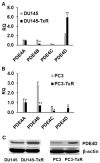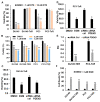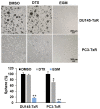Eggmanone Effectively Overcomes Prostate Cancer Cell Chemoresistance
- PMID: 34066000
- PMCID: PMC8151738
- DOI: 10.3390/biomedicines9050538
Eggmanone Effectively Overcomes Prostate Cancer Cell Chemoresistance
Abstract
Prostate cancer chemoresistance is a major therapeutic problem, and the underlying mechanism is not well understood and effective therapies to overcome this problem are not available. Phosphodiesterase-4 (PDE4), a main intracellular enzyme for cAMP hydrolysis, has been previously shown to involve in the early chemo-sensitive prostate cancer cell proliferation and progression, but its role in the more-advanced chemo-resistant prostate cancer is completely unknown. Here we found that the expression of PDE4 subtype, PDE4D, is highly elevated in the chemo-resistant prostate cancer cells (DU145-TxR and PC3-TxR) in comparison to the chemo-sensitive prostate cancer cells (DU145 and PC3). Inhibition of PDE4D with a potent and selective PDED4 inhibitor, Eggmanone, effectively decreases the invasion and proliferation as well as induces cell death of the chemo-resistant prostate cancer cells (DU145-TxR and PC3-TxR). These results were confirmed by siRNA knockdown of PDE4D. We and colleagues previously reported that Eggmanone can effectively blocked sonic Hedgehog signaling via PDE4D inhibition, and here our study suggests that that Eggmanone downregulated proliferation of the chemo-resistant prostate cancer cells via sonic Hedgehog signaling. In addition, Eggmanone treatment dose-dependently increases docetaxel cytotoxicity to DU145-TxR and PC3-TxR. As cancer stem cells (CSCs) are known to be implicated in cancer chemoresistance, we further examined Eggmanone impacts on CSC-like properties in the chemo-resistant prostate cancer cells. Our study shows that Eggmanone effectively down-regulates the expression of CSCs' marker genes Nanog and ABC sub-family G member 2 (ABCG2) and attenuates sphere formation in DU145-TxR and PC3-TxR cells. In summary, our work shows that Eggmanone effectively overcomes the chemoresistance of prostate cancer cells presumably through sonic Hedgehog signaling and targeting CSCs, suggesting that Eggmanone may serve as a novel agent for chemo-resistant prostate cancer.
Keywords: Eggmanone; Phosphodiesterase-4; cancer stem cells; chemoresistance; prostate cancer.
Conflict of interest statement
The authors declare no conflict of interest.
Figures







Similar articles
-
Down-regulation of E-cadherin enhances prostate cancer chemoresistance via Notch signaling.Chin J Cancer. 2017 Mar 29;36(1):35. doi: 10.1186/s40880-017-0203-x. Chin J Cancer. 2017. PMID: 28356132 Free PMC article.
-
BMP signaling inhibition overcomes chemoresistance of prostate cancer.Am J Cancer Res. 2023 Sep 15;13(9):4073-4086. eCollection 2023. Am J Cancer Res. 2023. PMID: 37818054 Free PMC article.
-
CCL2 induces resistance to the antiproliferative effect of cabazitaxel in prostate cancer cells.Cancer Sci. 2019 Jan;110(1):279-288. doi: 10.1111/cas.13876. Epub 2018 Dec 7. Cancer Sci. 2019. PMID: 30426599 Free PMC article.
-
The CCL2-CCR2 Axis Contributes to Migration of Cabazitaxel-resistant Prostate Cancer Cells.Anticancer Res. 2023 Jun;43(6):2561-2569. doi: 10.21873/anticanres.16423. Anticancer Res. 2023. PMID: 37247914
-
Quercetin and Its Nano-Scale Delivery Systems in Prostate Cancer Therapy: Paving the Way for Cancer Elimination and Reversing Chemoresistance.Cancers (Basel). 2021 Mar 31;13(7):1602. doi: 10.3390/cancers13071602. Cancers (Basel). 2021. PMID: 33807174 Free PMC article. Review.
Cited by
-
Biomarker discovery for practice of precision medicine in hypopharyngeal cancer: a theranostic study on response prediction of the key therapeutic agents.BMC Cancer. 2022 Jul 16;22(1):779. doi: 10.1186/s12885-022-09853-1. BMC Cancer. 2022. PMID: 35841085 Free PMC article.
References
Grants and funding
LinkOut - more resources
Full Text Sources
Research Materials

